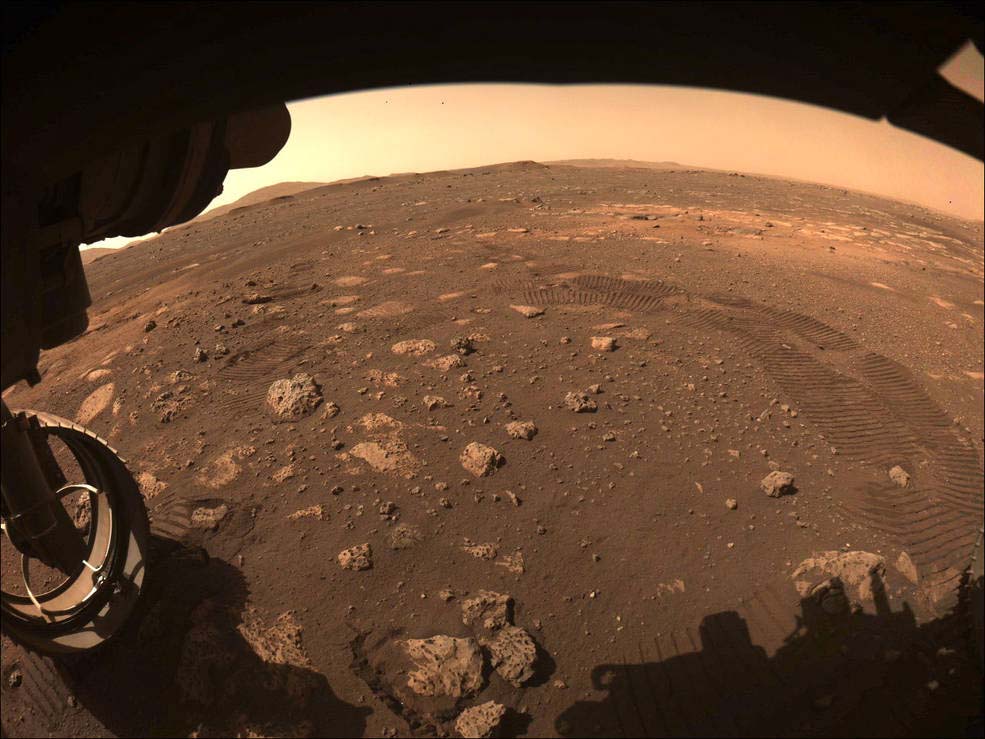NASA’s Mars 2020 Perseverance rover performed its first drive on Mars on 4 March, covering 6,5m across the Martian landscape.
The drive served as a mobility test that marks just one of many milestones as team members check out and calibrate every system, subsystem, and instrument on Perseverance. Once the rover begins pursuing its science goals, regular commutes extending 200m or more are expected.
“When it comes to wheeled vehicles on other planets, there are few first-time events that measure up in significance to that of the first drive,” says Anais Zarifian, Mars 2020 Perseverance rover mobility test bed engineer at NASA’s Jet Propulsion Laboratory. “This was our first chance to ‘kick the tires’ and take Perseverance out for a spin. The rover’s six-wheel drive responded superbly. We are now confident our drive system is good to go, capable of taking us wherever the science leads us over the next two years.”
The drive, which lasted about 33 minutes, propelled the rover forward 4m, where it then turned in place 150 degrees to the left and backed up 2,5m into its new temporary parking space.

This image was captured while NASA’s Perseverance rover drove on Mars for the first time on March 4, 2021. One of Perseverance’s Hazard Avoidance Cameras (Hazcams) captured this image as the rover completed a short traverse and turn from its landing site in Jezero Crater.
Credits: NASA/JPL-Caltech
To help better understand the dynamics of a retrorocket landing on the Red Planet, engineers used Perseverance’s Navigation and Hazard Avoidance Cameras to image the spot where Perseverance touched down, dispersing Martian dust with plumes from its engines.
The rover’s mobility system is not the only thing getting a test drive during this period of initial checkouts. On 26 February – Perseverance’s eighth Martian day, or sol, since landing – mission controllers completed a software update, replacing the computer program that helped land Perseverance with one they will rely on to investigate the planet.
More recently, the controllers checked out Perseverance’s Radar Imager for Mars’ Subsurface Experiment (RIMFAX) and Mars Oxygen In-Situ Resource Utilization Experiment (MOXIE) instruments, and deployed the Mars Environmental Dynamics Analyzer (MEDA) instrument’s two wind sensors, which extend out from the rover’s mast. Another significant milestone occurred on March 2, or sol 12, when engineers unstowed the rover’s 2m-long) robotic arm for the first time, flexing each of its five joints over the course of two hours.
“Tuesday’s first test of the robotic arm was a big moment for us,” says Robert Hogg, Mars 2020 Perseverance rover deputy mission manager. “That’s the main tool the science team will use to do close-up examination of the geologic features of Jezero Crater, and then we’ll drill and sample the ones they find the most interesting. When we got confirmation of the robotic arm flexing its muscles, including images of it working beautifully after its long trip to Mars – well, it made my day.”
Upcoming events and evaluations include more detailed testing and calibration of science instruments, sending the rover on longer drives, and jettisoning covers that shield both the adaptive caching assembly (part of the rover’s Sample Caching System) and the Ingenuity Mars Helicopter during landing. The experimental flight test program for the Ingenuity Mars Helicopter will also take place during the rover’s commissioning.
Through it all, the rover is sending down images from the most advanced suite of cameras ever to travel to Mars. The mission’s cameras have already sent about 7 000 images. On Earth, Perseverance’s imagery flows through the powerful Deep Space Network (DSN), managed by NASA’s Space Communications and Navigation (SCaN) program. In space, several Mars orbiters play an equally important role.
“Orbiter support for downlink of data has been a real gamechanger,” says Justin Maki, chief engineer for imaging and the imaging scientist for the Mars 2020 Perseverance rover mission at JPL. “When you see a beautiful image from Jezero, consider that it took a whole team of Martians to get it to you. Every picture from Perseverance is relayed by either the European Space Agency’s Trace Gas Orbiter, or NASA’s MAVEN, Mars Odyssey, or Mars Reconnaissance Orbiter. They are important partners in our explorations and our discoveries.”
More about the mission
A key objective of Perseverance’s mission on Mars is astrobiology, including the search for signs of ancient microbial life. The rover will characterize the planet’s geology and past climate, pave the way for human exploration of the Red Planet, and be the first mission to collect and cache Martian rock and regolith.
Subsequent NASA missions, in cooperation with ESA (European Space Agency), would send spacecraft to Mars to collect these sealed samples from the surface and return them to Earth for in-depth analysis.
The Mars 2020 Perseverance mission is part of NASA’s Moon to Mars exploration approach, which includes Artemis missions to the Moon that will help prepare for human exploration of the Red Planet.
